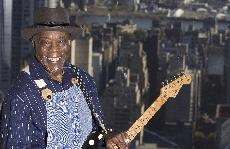Accolades keep coming for blues guitarist Buddy Guy

Musician Buddy Guy is photographed in New York, Oct. 30. The Associated Press
Nov 30, 2006
Last updated on May 12, 2016 at 06:35 a.m.
Sitting in his record label’s offices, high above the Manhattan skyline, blues legend Buddy Guy looks at a table lined with six of his signature Polka Dot Fender Stratocaster guitars, all of which are awaiting his famous autograph.
But first, the blues legend takes a moment to recall their significance – all the way back to 1957, when Guy left Louisiana to chase his guitar dreams all the way to Chicago.
“To make my mother feel good about me leaving I said, ‘I’m going to show you I’m doing so good I’m going to drive back here in a polka-dot Cadillac,'” he recounts with a smile.
Although the spotty sentiment wasn’t entirely serious, Guy paid tribute to his mother, who died in 1968, once he felt he achieved real success.
Get The Daily Illini in your inbox!
“I said I’m going to get a polka-dot guitar. And I know wherever she is she’s smiling.”
These days, Guy is smiling as well. Though he toiled for much of his career out of music’s spotlight – inspiring the likes of Eric Clapton and Keith Richards while being ignored by the mainstream – in his later years, he’s gotten accolade after accolade.
From his best-selling record in 1991, “Damn Right, I’ve Got the Blues” to Grammy trophies and his belated induction into the Rock and Roll Hall of Fame just last year, the mainstream is finally giving the 70-year-old Guy his due.
And a recently released three-disc/DVD boxed set “Can’t Quit the Blues” shows why he merits such admiration. It features highlights from his 50-year career as a blues guitarist, including never released tracks, along with collaborations with greats like Muddy Waters, Clapton and Richards, to newer talent like John Mayer, Jonny Lang and Keb’ Mo’.
“There’s a certain abandon that Buddy has that he relies on more than other people,” says Mayer of his hero-turned-friend. “It’s an unchained energy. Buddy Guy is what makes the electric guitar electric.”
Ever the showman, Guy’s music has always come from his heart more than his head, being that to this day he can’t read sheet music, and delights in both the spontaneity and sloppiness that comes with improvising (which at times meant playing the guitar with his feet and teeth).
“I didn’t want to play what was written,” he explains. “And it worked.”
However, the journey from picking cotton on a plantation to picking strings on stages across the world as a card-carrying guitar icon was an arduous one. After famously being taken under the tutelage of Muddy Waters and Howlin’ Wolf in Chicago, Guy became a peer of those whose styles he had echoed, but he was less successful in seeing the financial fruits of his labor.
“Everybody was getting ripped off,” he says. “Elvis Presley would have probably lived longer if he knew how much Col. (Tom) Parker was ripping him off. But a lot of the people who ripped us off were dead and you can’t get revenge off a dead person.”
Of course, black artists were being neglected in other ways as well.
“The British guys introduced us to white America,” says Guy of artists like Mick Jagger, Clapton and Jeff Beck who, when they came over as part of the British invasion, credited him as an influence at a time when he couldn’t even get a record deal.
“They made us go places we’d never been before.”
And though now some believe being able to play the blues means having actually lived the blues, or at least being of a certain hue, Guy dismisses such musical prerequisites as absurd.
“If you got the same amount of fingers as I got, I don’t have an advantage over you just because my skin is black. The only advantage I’d have was if I had an extra finger,” he says, holding up his hand, then chuckling: “We did have a guitar player named Hound Dog Taylor who did have an extra little finger but he couldn’t use it.”
Guy would rather dispel the awe surrounding his genre, and see it move into the mainstream, which is why he encouraged blues-rock progeny John Mayer to release a blues album, which he did as a live album in 2005.
“Every once in a while a young person needs to come along and fire up the record company and remind them that the blues is still alive,” says Guy, who recognizes that MTV favors youth and beauty over experience.
“My challenge is to defend blues as it exists in my pop music,” says the 29-year-old Mayer. “My fans know who Buddy is and that’s important to me.”
Mayer not only admires Guy’s musical know-how, but also the way that he’s conducted his career.
“I can’t think of anyone else today who would stick to their guns under such oppressive conditions. He’s proof that keep your head down and play, people will notice.”





